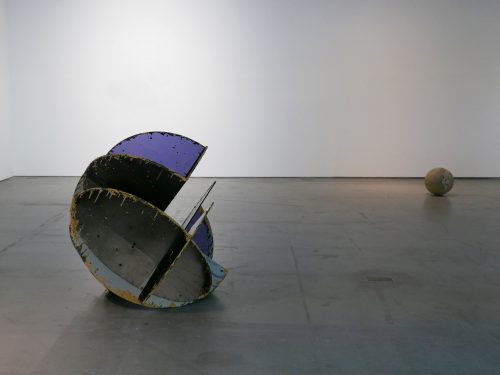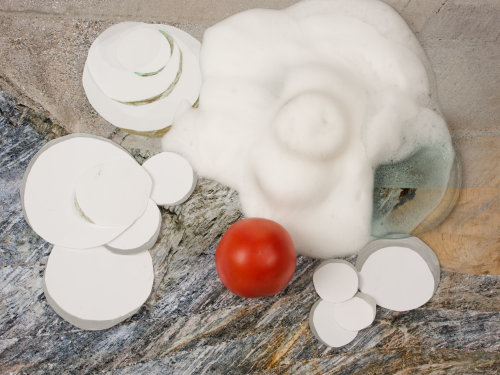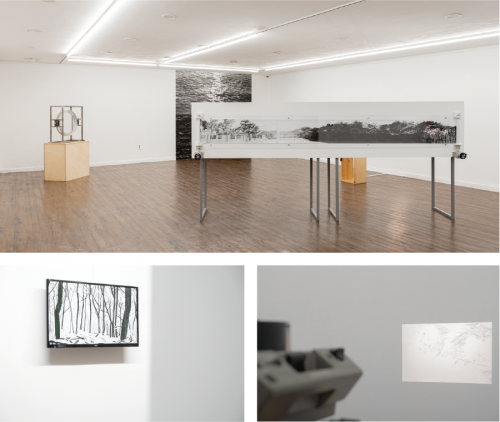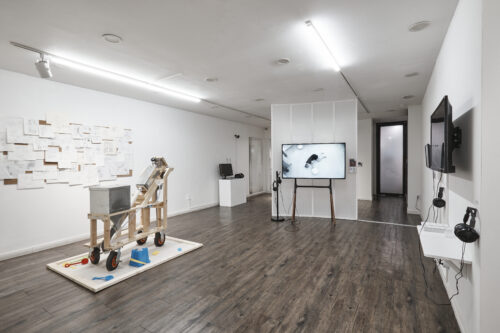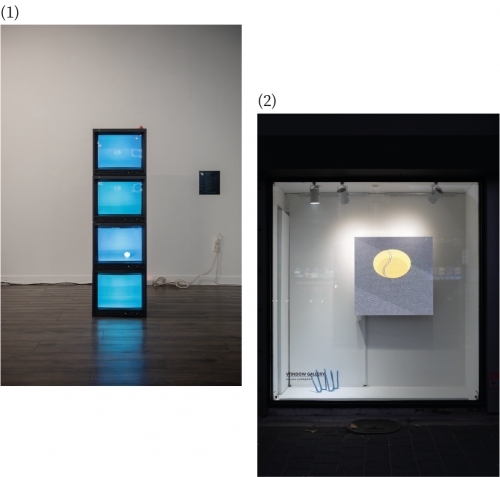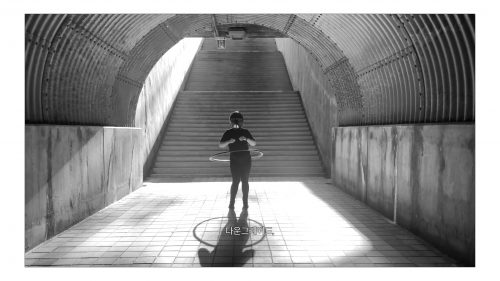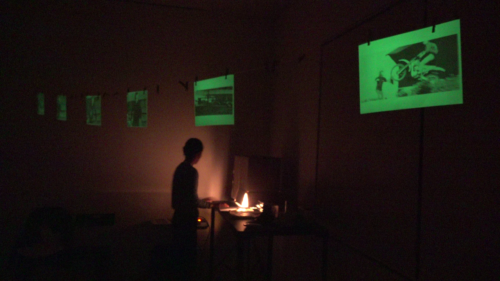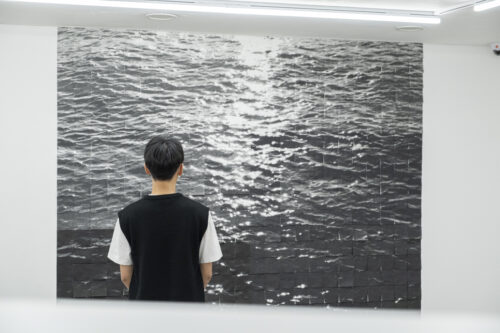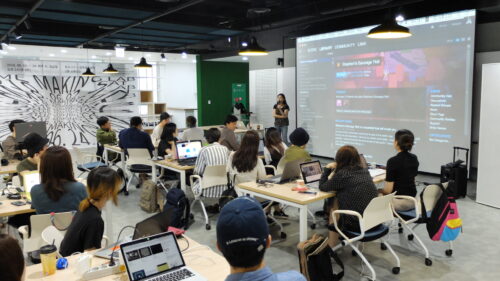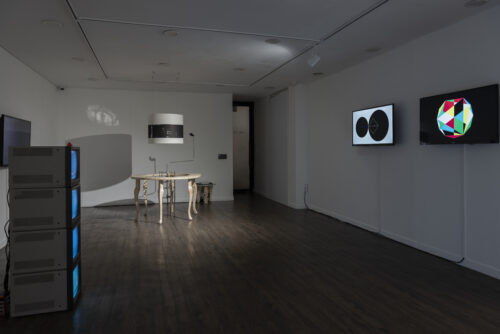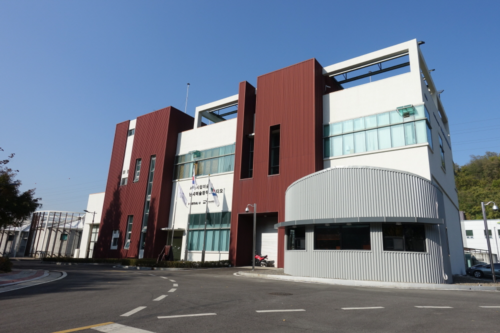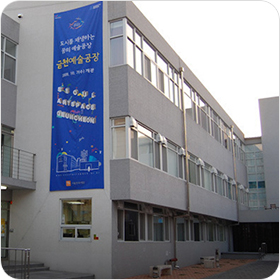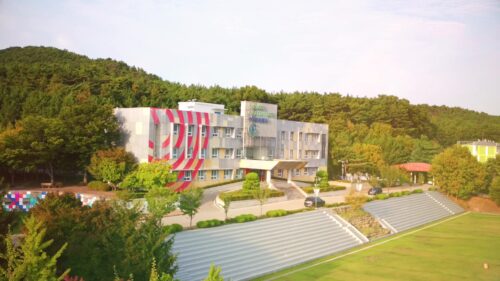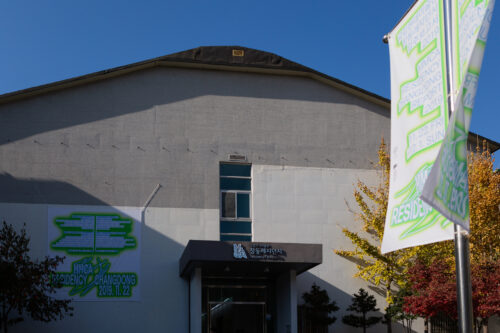우리가 보낸 시간을 어떤 말로 표현할 수 있을까?
인간은 매 순간 온몸의 감각신경 가지들로부터 주변의 자극을 받아들이는 다중감각 수용체이다. 나를 둘러싼 자극을 끊김 없이 연속 재생한다. 그 가운데 보고 싶은 것을 보고, 듣고 싶은 것을 듣는다. 간혹 소리를 만지고, 냄새를 맛보고, 형태를 듣거나 말의 냄새를 맡는 일이 우리 가운데 일어나기도 한다. 물론, 이 모든 일은 개별의 존재에게 각기 다른 신호와 강도로 작동한다. 그러니 우리가 인지하는 모든 것들은 사실, 기대하는 것들에 의해 결정된다고 말할 수도 있을 것이다.
코로나 이후 개인·공동체의 상황에 따라 달리 체감되는 ‘시간’과 ‘공간’이 생겨났다. 어떤 곳은 디딜 수 없는 곳이 되었고, 어떤 날은 언제일지 모르는 시간으로 어딘가를 떠돈다. 이것을 언제고 다시 불러드릴 수 있는 동시대에 관한 모음집으로 남기고 싶었다. 온몸으로 받아들인 개별의 순간을 하나의 단어, 동사로 가만 마주하는 일. 각자가 마주한 시간에 대한 동사를 골라 지금을 기록해보기로 했고, 이 기록에 ‘시간-동사-모음’이라는 이름을 붙였다.
《시간동사모음 TAP-Time based Art Project-Collection》은 시간의 움직임이 의미 전개에 작용하는 시간기반예술(time-based Art)에 관하여 여러 매체를 통해 접근하고, 현재를 관통하는 시간을 다양한 동사형으로 해석한 작가와 작품을 소개하는 기획전이다. 시간기반예술은 전통적 시간관을 해체하거나 재구성하는 방식으로의 접근에서부터, 시간과 관계하는 여러 매체 유형에 따라 다양한 예술 실천을 토대로 발전해왔다. 때문에 시간의 추이에 따른 작업 유형으로 전통매체에서부터 무빙 이미지, 퍼포먼스, 사운드, 설치 등을 포함하며 테크놀로지의 변모에 따라 다변화한 매체를 포괄한다. 이번 전시에서는 작품의 지지체로서 시간성을 다루는 매체 탐구에 앞서, 스케일·작업구현 방식·주제적 측면에서 관객이 자신만의 시간-호흡으로 작품을 감상하게 하는 여러 시도에 관해 살펴보고자 한다. 이와 함께 ‘시간’을 가시적인 형태로 구현한 장치인 시계를 모티브로, 작가별로 명명한 시간 동사에 따라 크기와 속도가 다른 시간 조각으로 구성된 시간 장치를 상상해보았다. 시계는 실제 전시장과 온라인에 놓여, 같고 다른 속도로 시간을 달린다. 여러 차원과 형태를 반복적으로 오가며 시간성에 관한 체감을 새롭게 하는 이러한 구성은 현재에 관한 시간의 흐름을 다양한 방식으로 인지하게 한다.
성북예술창작터(성북구립미술관 분관)에서 올해 첫 프로젝트로 개최되는 이번 전시는 성북을 하나의 예술 동네로 상정하고 예술가, 예술공간, 관련 종사자들이 중심이 되는 시각예술 네트워크 활성화 프로젝트인 ‘성북예술동’의 일곱 번째 프로젝트로 기획되었다. 성북동 곳곳의 실제 공간에서 진행되던 성북예술동은 성북예술창작터에서 열리는 전시 《시간동사모음》을 포함하여, 미술관 네트워킹 범위와 대상을 확장하고 다양한 시간동사 모음을 위해 서울/경기권 내 국공립미술관과 문화재단에서 운영되는 레지던시·시각예술 창작기관과의 협업을 통해 총 5개 기관, 23명(팀)의 기획자 및 작가와 함께하는 동명의 온라인 전시 <시간동사모음>이 진행된다. 창작자/공간 아카이브를 위한 웹사이트 <성북 아트 딕셔너리(Seongbuk Art Dictionary)>도 함께 운영된다.
오프라인 전시에는 총 7명의 작가와 15점의 작품이 함께한다. 권세진은 흘러가는 시간의 단면을 포착하고 마치 시간-조각모음 하듯 풍경을 직조해나가는 작업방식을 진행하며, 576개의 드로잉으로 구성된 바다 앞에서 풍경 너머로 지나가는 시간을 지속한다. 김기철은 소리를 눈으로 볼 수 있는 형태에 관한 고민으로 들을 수 있고 만질 수 있는 형태의 소리를 상상하며 시간을 듣게 한다. 김용관은 시공간을 여러 방향으로 중첩하여 바라보게 하는 영상과 이야기를 통해 시간의 반복(혹은 그 반대)을 이야기한다. 김태윤은 시간의 움직임과 상대적 인식에 관한 관심으로 시간의 흐름이 드러나는 일상 속 장면을 수집하여 선형적 시간을 순환적 형태와 구조를 가진 리듬으로 표현하며 시간을 마주한다. 송예환은 작가-작품이 가진 시간동사와 전시장에 흐르는 물리적 시간을 웹으로 옮겨온 두 가지 종류의 시계를 선보이며 흐르는 시간을 목도한다. 이경민은 이미지 이면에 숨어있는 본질에 대한 관심으로 디지털 매체를 이용하여 일상의 단면을 수집하고 수십 미터에 달하는 종이에 드로잉하여 종이-비디오로 기록했으며 이를 통해 시간을 (담아)보낸다. 이예승은 물리적 세계가 가진 종합성과 이를 비추는 ‘눈(시선)’에 따라 세계의 특정한 부분만을 인식하게 되는 현재에 관하여 여러 주어와 목적어에 따라 감각되는 시간에 관해 질문한다.
시간은 어떤 방식으로 만질 수 있는 실제 표면을 가진 ‘물질’이 되어가고 있는가? 시간의 단면을 포착하던 시도는 시간의 흐름을 (반)영구적으로 저장하는 세계로 확장해나가는 듯 보인다. 이번 전시를 통해 시간기반예술이 포용하는 다양한 매체와 발달한 기술에 따른 미디어 지형도에 관한 질문의 계기가 되길 바란다. 시간을 담은 조각들이 멈추고 달리는 것을 반복하며 제 시간을 지날 때, 서로 다른 조각과 겹을 이루는 연결의 순간이 지속되기를 기대해본다.
안성은 (성북구립미술관 성북예술창작터 큐레이터)
In what words can we express the time we spent?
Human beings are multi-sensory receptors that receive various stimuli from the surroundings transferred by the peripheral sensory nerve branches every second. This stimuli system is on continuous relay. We choose to see what we want to see and hear what we want to hear. It often occurs when we touch sound, taste smell, hear images, or smell words. Of course, these occurrences appear through different signals and intensity for each individual being. So we might say that everything we perceive is actually determined by what we anticipate.
Since COVID-19, a new concept of ‘time’ and ‘space’ appeared; depending on the situation of the individual and community, time and space are felt uniquely. Some places became off limits, and some days wander somewhere with no time to know when. I wanted to collect these as records of the contemporary that could be recalled anytime, by facing the individually perceived moments with a single word, a verb. By selecting a verb to represent each time of each individual, the present is recorded, and they are titled ‘TAP-Time based Art Project-Collection’.
《TAP-Time based Art Project-Collection》 is an exhibition that presents works and artists that approach time-based art(where the movement of time acts on the development of meaning) through various media, and interpret the present time using different verbs. Started with the attempt to dismantle or reconstruct the traditional viewing of time, time-based art has developed based on various art practices according to a spectrum of mediums related to ‘time’. Therefore, it is a type of work that is affected by the course of time, including traditional medium such as moving image, performance, sound, and installation, to diversified medium due to technological advancements. Before examining its methods and media, 《TAP Collection》 explores the various attempts in inviting the audience to appreciate the work at their own scale·work-implementation·subject. Along with this, a time device composed of different fragments of time is imagined then realized, inspired by clock. This device embodies ‘time’ in a visible form, with each fragment in different scale and speed according to each artist’s time verb. The device is displayed in the exhibition space and also online, running at same but different speed. Such composition which is running through distinct dimensions and forms, thus renewing the sense of time, makes the perception of the current flow of time differ.
The first project of the year at SeongBuk Young Art Space (from Seongbuk Museum of Art; SMA), 《TAP Collection》 identifies Seongbuk as an individual art neighborhood, therefore including the exhibition as the seventh project of the ‘Seongbuk Art Commons’ a project to vitalize visual arts network with artists, art space, and related field workers at its core. The Seongbuk Art Commons, which has been held in various spaces in Seongbuk-dong, expands the scope and subject of the museum’s network and collects various time verbs by collaborating with the national and public museums in Seoul/Gyeongi-do and residency/creative institutions run by cultural foundation. A total of 5 organizations with 23 team/curators collaborate for an online exhibition under the same name, <TAP Collection>, in addition to <Seongbuk Art Dictionary>, an online archive for the creators and documentation of the space.
In the offline exhibition, a total of 7 artists and 15 pieces of artwork are on display. SeJin Kwon captures the cross section of time and adopts the method of weaving the landscape, as if putting puzzle pieces of time together. In front of the sea consisting of 576 drawings, the time passes by over the scene. KiChul Kim makes the audience listen to time by imagining the tactile forms of sound through explorations of its visible shapes. YongKwan Kim tells the repetition of time (or vice versa) through video and story with multiple point of views on time and space. TaeYoon Kim pays interest to movements of time and concepts of relative recognition, by collecting scenes in daily life that show apparent passing of time and reconfiguring those linear time into rhythms of circular structures and forms. YeHwan Song observes the flowing time by presenting two types of clock; a clock from artist’s time verb; and another from actual time in the exhibition space transferred into the web. With interest in the essence behind images, KyungMin Lee collects bits of everyday life using digital media, draw them on meters of paper or record them in video, and spends time through them. YeSeung Lee makes inquiries about the time as sensed by various subject and object, in relation to the present that recognizes only a specific part of the world according to the comprehensiveness of the physical, and the ‘(one’s) eyes’ that shine light on it.
How is time becoming a touchable ‘material’ with real surface? The attempt to capture the cross section of time seems to expand into the world of (semi)permanent storage of the passage of time. We hope this exhibition serves as an opportunity to inquire the various media embraced by time-based art and the media topography on technological advancements. When fragments of time stop and repeat running, we expect the pieces will connect and overlap — and this moment of connection will continue to last.
SeongEun An (Curator, SMA SeongBuk Young Art Space)

성북예술창작터
서울시 성북구 성북로23
T. 02-2038-9989
E. SeongBukYoungArtSpace@gmail.com
H. sma.sbculture.or.kr/youngartspace
–
주최 성북구 주관 성북문화재단 성북구립미술관, 성북예술창작터 협력 경기문화재단 경기창작센터, 국립현대미술관 창동레지던시, 서울문화재단 금천예술공장, 서울시립미술관 난지미술창작스튜디오, 한국예술종합학교 융합예술센터
총괄 김보라 기획 및 운영 안성은 시설 조수연 스탭 강영진, 이주환
그래픽 송예환, 김혜수 웹개발 송예환 사진 최요한 영상 강영진 번역 김민주

Seongbuk Young Art Space
23, Seongbuk-ro, Seongbuk-gu, Seoul, 02880, Republic of Korea
T. +82-2-2038-9989
E. SeongBukYoungArtSpace@gmail.com
H. sma.sbculture.or.kr/youngartspace
Host Seongbuk-gu Organizer Seongbuk Cultural Foundation, Seongbuk Museum of Art, Seongbuk Young Art Space Support GGCF Gyeonggi Creation Center, MMCA Residency Changdong, SFAC Art Space GEUMCHEON Residency, SeMA NANJI RESIDENCY, K-ARTs Art Collider
Supervisor Kim BoRa Curator An SeongEun Facility Cho SuYeon Staff Kang YoungJin, Lee JooHwan
Graphic Design Song YeHwan, Kim HyeSu Web develop Song YeHwan Photo Choi YoHan Video Kang YoungJin Translation Kim MinJoo
